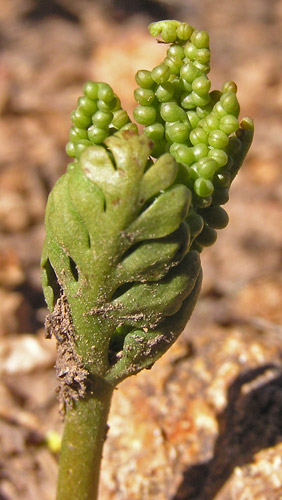
|
Family: Ophioglossaceae |
Plants terrestrial. Roots occasionally branching laterally, yellowish to black, 0.5--2 mm diam., smooth or with corky ridges, not proliferous. Stems upright, forming caudex to 5 mm thick; gemmae absent or minute, spheric. Trophophores ascending to perpendicular to stem, sessile or stalked; blades linear, oblong, or deltate, simple to 5-pinnate, 4--25 × 1--35 cm. Pinnae (reduced to segments in many species) spreading to ascending, fan-shaped to lanceolate to linear; margins entire to dentate to lacerate, apex rounded or acute; veins free, arranged like ribs of fan or pinnate. Sporophores normally 1 per leaf, 1--3-pinnate, long-stalked, borne at ground level to high on common stalk. Sporangial clusters with sporangia sessile to short-stalked, almost completely exposed, borne in 2 rows on pinnate (except in very small plants) sporophore branches. Gametophytes broadly ovate, unbranched, 1--3 × 1--10 mm. x =44, 45, 92. The greatest diversity in Botrychium is at high latitudes and high elevations, mostly in disturbed meadows and woods. Extensive field and laboratory research has revealed unexpected diversity in North America, especially in subg. Botrychium . For accurate identification, a substantial number of carefully spread and pressed leaves are usually needed because of the large amount of variation found in most species. Taking many samples will have little effect on the population as long as the underground shoots and roots are left intact. Approximately a dozen sterile hybrid combinations have been encountered, but they are very infrequent. The range maps south of Canada reflect mostly local occurrences at high elevations (1000--3700 m) in the mountains. The ranges for many of the species are probably more extensive and continuous than indicated by our present knowledge.
Lvs glabrous or sometimes with simple hairs; blades mostly pinnately or ternate-pinnately or subpalmately compound or dissected, seldom simple, the veins forked and free; sporophore 1-several times pinnate, the numerous sporangia short- stalked and free, spores 1500-2000. 30+, cosmop. Depauperate or juvenile plants of related spp. are scarcely to be distinguished; spp. 5-10 are morphologically confluent, but said to be genetically distinct. Gleason, Henry A. & Cronquist, Arthur J. 1991. Manual of vascular plants of northeastern United States and adjacent Canada. lxxv + 910 pp. ©The New York Botanical Garden. All rights reserved. Used by permission. |
This project was made possible in part by the Institute of Museum and Library Services [MG-70-19-0057-19].
Powered by Symbiota



